Gibb River Road
(Broome to Kununurra)
back to top
Broome - Derby - Windjana Gorge NP - Tunnel
Creek NP - Silent Grove Cons. Park - Bell Gorge - Adcock
- Gorge - Galvans Gorge - Mt Barnett Roadhouse - Manning
Falls - Gibb River Crossing - Mitchell Falls - Drysdale River
Station - Pentecost River - Kununurra - Ivanhoe Crossing
On Friday, August 25, we leave Broome in direction of Derby.
We find Derby to be a sleepy little town
with a well stocked Woolworth.
Shame we did not know about the restaurant at the end of
the pier ... but there will be a next visit here and we will
include a sunset with a good dinner in our planning.
We hit the Gibb River Road in direction
of the Windjana Gorge and soon the road gets narrower and
some great examples of bottle or boab trees (Adansonia gregorii)
appear.
Because of the dry season the trees have dropped their leaves.
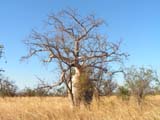
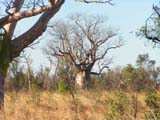
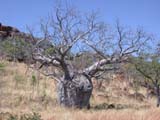
The boab tree is known as baobab in Africa.
The tree can be found all over the Kimberleys.
Funny enough they tell the same story about the tree in
Africa as the Aboriginals tell in Australia:
The boab was a very proud and arrogant tree.
He kept telling everybody that he was the most beautiful
tree on earth.
The Gods got so upset about this behaviour that they pulled
the tree out of the ground and stuck it back in upside down.
What you see are roots and not branches .... looks a bit
like that, doesn't it?
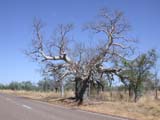
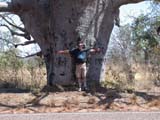
Some boabs have an amazing diameter.
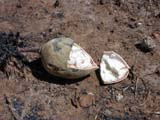
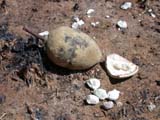
The fruit pods contain cotton-like fluffy material and some
pits.
According to the Bush Tucker Man Les Hiddings the pits are
edible, taste like powder-milk and are very nutritious.
Some Aboriginals engrave the pods and sell them as souvenirs.
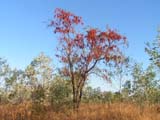
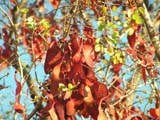
We also see trees with bright red bean-shaped fruits on
them.
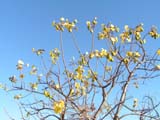
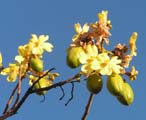
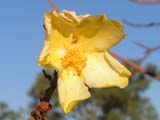
The Native Kapok Bush (Cochlospermum fraseri) is spread
all over the Kimberleys and we find many trees still covered
in flowers.
The green fruit capsules will eventually dry and pop open
to release a fluffy cotton-like material.
We saw such capsules in November 1995 when visiting the Kimberleys
the first time.
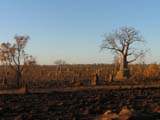
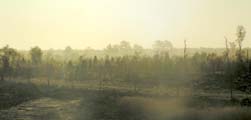
We find a camp spot some 100 km from Derby and decide to
stay for the night.
After a dusty day with temperatures around 30°C and a
humidity of 22 % we absolutely enjoy our hot shower in the
evening.
The night is cool with only 18°C.
The next morning is a bit foggy and does not start that
well. While going through his checklist Ruedi finds that
the engine needs oil.
As we had left Perth in a mad rush we had forgotten to buy
some oil. This means returning to Derby ....
The manual says that we needed a particular oil from Valvoline
which neither of the service stations in Derby has on stock.
Because we are doing the first 10'000 km on a new engine
Ruedi wants to use an oil with the same specifications as
the one described in the manual.
We decide to call OKA and get some more details off them.
Being Saturday nobody answers the phone at OKA.
So we call Arthur and ask him the specifics of the Valvoline
oil so we can buy the same quality oil form another brand.
He does not know either but will find out.
After a while Linden, the developer from OKA, calls back.
Cummings is closed on Saturdays and he cannot get any other
details.
So we agreed to buy the oil with the closest Cummings specifications.
A whole litre of oil goes into the engine.
But guess what, we never needed a drop of oil after that
for the next 10'000 kms.
We take off again and this time make it to Windjana
Gorge NP. The temperature climbs to 42°C and
the heat is reflected from the ground.
We have to get used to this temperatures first .... but it
feels great.
In the evening the corellas come back to the gorge. We
are disappointed about the numbers.
When we were here in November 1995 there must have been hundreds
if not thousands of them flying back. We had watched the
birds for close to 1/4 of an hour flying in large flocks.
Then the flying foxes leave the gorge. Again we are disappointed
about the numbers.
According to the guide book they only are present in large
numbers when all other waterholes have dried up.
It looks like there is still too much water around and we
have to come back another time in a November to experience
this phenomena again.
After a comfortable night with 20°C the birds start
singing at 5 AM in the morning. Shortly after the corellas
leave the gorge and scream their heads off.
What a great way of being woken up on a Sunday morning.
We expect another hot day and start the day early. We have
to repack most of the cabinets and also the hatches.
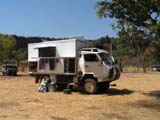
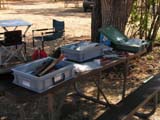
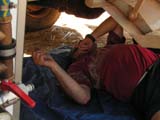
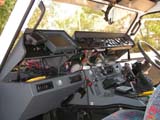
Ruedi has to finish some of the electrical work too.
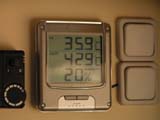
We are surprised how cool the cabin stays even with this
hot temperatures outside.
As most of the campers move on we shift to a site with trees
and reserve a space for Judith and Guido who will be joining
us later on today.
Judith and Guido bring some impressive photos from their
trip from Derby to the horizontal waterfalls.
They also bring some surprises.
We have told them in Broome that we want to give the OKA
a proper name in Windjana Gorge. So they have done some shopping
and sent us away for at least 45 minutes to prepare all.
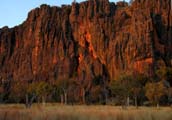
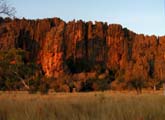
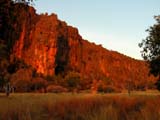
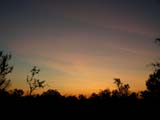
We enjoy a stunning sunset at the gorges entry.
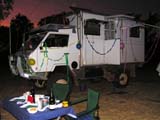
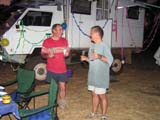
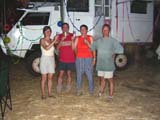
On returning we find the table set with candles and the
OKA decorated.
After an impressive dinner with entree, main-course and desert
the OKA is "christened" with some sparkling wine
to the name of "Villa Compactus".
Judith and Guido, thanks again for this nice suprise!
The cool Monday morning with only 19°C is perfect for
a bit of hiking in the gorge.
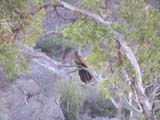
As we walk towards the gorge we hear a hissing sound from
one of the close trees, like a cat-fight.
We see a large bird flying into a tree. Our bird book later
on tells us that it most probably a Pheasant Coucal or a
long-tailed Koel.


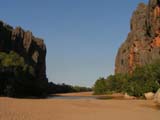
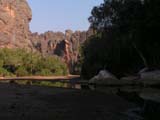
The gorge presents itself from the best side.

Soon we sight the first crocodile tracks. They sleep on
the embankments of the river and stay in the water only during
the day.
Then we also see the crocodiles in the water.
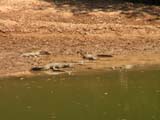
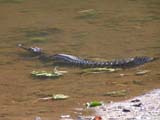
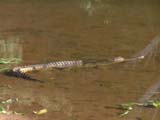
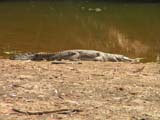
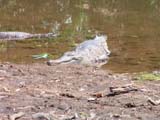
The crocodiles at Windjana Gorge are freshwater crocodiles
or freshies (Crocodylus johnstoni).
They have a smaller body than the saltwater crocodiles and
their snout is narrower and longer.
They are shy but they will attack if they feel threatened
or cornered.
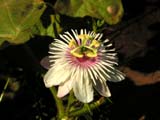
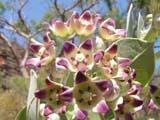
We find some beautiful flowers, some we know like the wild
passion fruit, other we don't ....
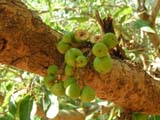
We find a nice bunch of Cluster Fig (Ficus racemosa).
What a shame that they are not ripe yet. Apparently they
taste similar to cultivated figs.
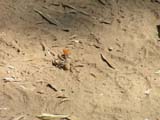
We also see a large spider dragging along a wasp. We follow
them for a while.
Suddenly we notice that it is the other way round: it is
the wasp dragging the spider to its nest!
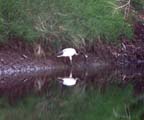
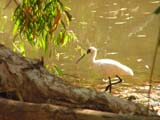
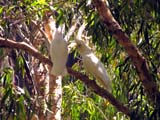
We also see many birds like a Sacred Ibis, a Royal Spoonbill
and of course lots of noisy Little Corellas.
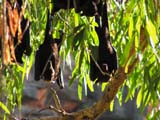

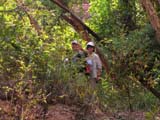
The flying foxes are cute and not shy at all.
Judith and Guido also enjoy how close on one can get to these
animals.
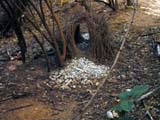
We find this beautiful example of a Bowerbird avenue bower.
According to the bird book the male Bowerbird builds and
maintains this nest purely to attract females.
The bower consists of two parallel rows of grass stuck into
a platform of twigs.
The male decorates the bower with shells, flowers, blue feathers,
bones, etc. that he might pinch from another Bowerbirds bower.
If the female finds the bower attractive they mate in there.
She then goes off and builds her own nest where she has the
young ones on her own.
He stays with his bower and continues courting and mating
with other females.
What a life!
In the afternoon we return to the camper and receive a visit
from neighbour Vanessa.
When she finds out that Ruedi plays the guitar she invites
us over after dinner for a jam-session with her husband Bruce.
We have a great time with the two guitarist entertaining
their audience until late.
Thanks Bruce!
It was fun hear you singing and playing with you.
Tuesday morning is rather fresh with only 17°C but the
clouds look stunning.
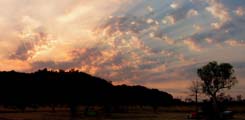
We head off to Tunnel Creek NP
.
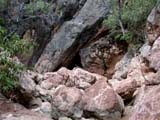
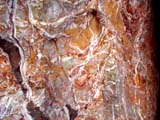
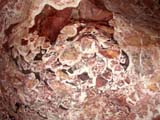
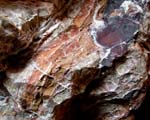
Finding the entry into the tunnel is not that easy. One
has to climb over some solid rocks.
The rocks display some impressive colours and pattern.
The way through the tunnel leads through water, at times
up to the knees.
It takes a bit of courage to go through this dark tunnel
with just a small flashlight in ones hand it but it is worth
it.

In the tunnel it is interesting to see the roots of the
trees standing on the surface tunnelling their way towards
the water.
First they come as very fine roots. Once they find the water
they get thicker and thicker and end up splitting the rocks.
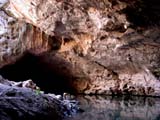

The roof of the cave then collapses.
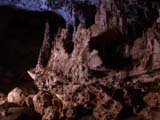
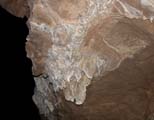

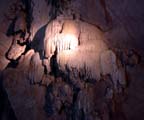
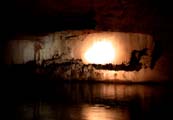
Tunnel Creek is best appreciated with a strong torch displaying
all the different rock formations, enclosures, stalagmites
and stalactites.
Lizard fishes, various sort of bats and flying foxes can
be found in the tunnel.
Careful! There is also at least one freshwater crocodile
living in the tunnel.
We almost stepped on it!
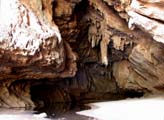
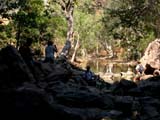
Reaching the other end of the tunnel we realise how hot
it had already become outside.
There is no other way back than again through the tunnel.
The freshie is still lying there, not being bothered at all
by the tourist passing it.
Coming out of the cool tunnel the hot cars feel even hotter!
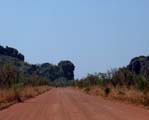
We drive further into the Kimberleys and see some interesting
rock formations.
See the head with the pointy noise?
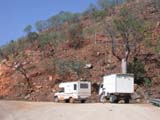

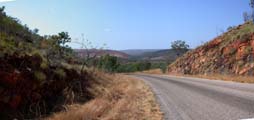
There are some good lookouts giving a fine view into the
mountains.
We are impressed to find them so rugged and wild.
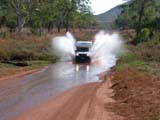
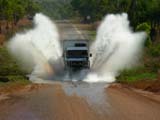
There are some excellent little crossings to be found even
at this time of the year and we have some fun.
Thanks to Judith for taking this great picture of the OKA.
You had your finger on the trigger in the right split second!
We reach Silent Grove Cons. Park shortly
after 2 pm and learn that the last badge for a camping site
at Bell Gorge had just been taken a short wile ago.
The ranger will distribute the free ones next morning at
7 am.
So we decide to stay at Silent Grove Cons. Park (S 17 04.023
E 125 14.873) for the night and enjoy the toilets with water,
long showers and the good quality water.
The temperature over night drops only to 20°C. But with
day temperatures in the mid 30s, 20°C feels fresh if
one is waiting for a badge early in the morning.
We get a nice site right beside the little creek.
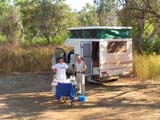
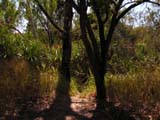
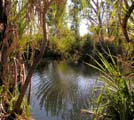
But we head straight up to Bell Gorge and
hike up to the waterfall where we stay all day.
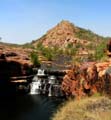
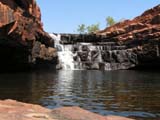
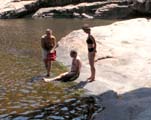
It is a very hot day with temperatures close to 38°C.
The water in the gorge is rather fresh.
For the brave ones there is a nice swim down the gorge with
some climbing sections over a few small falls.


Nature in Bell Gorge is very interesting too. The Pandanus
with their spiral fashion of arranging their leaves impressed
us.
But be careful, the leaves have very sharp teeth and cut
like knives!
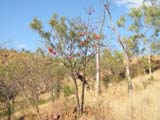
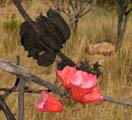
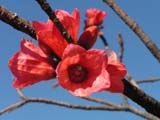
Above are some fine specimen of the Kimberley Rose or Red
Kurrajong (Brachychiton paradoxum) and their seed pods.
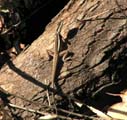
We start learning the difference between the various sorts
of lizards.
Many dragons have long hind limbs and when running they do
this in an upright position.
This Diporiphora albilabris (sorry, no easier name) is kind
enough to stand still until Susi has taken the photo.
In the evening we enjoy the privacy of our campsite.
Even tough we have our own access to the water somehow nobody
dares to go for a swim.
We rather watch the little turtles paddling around at the
creek.
Bell Gorge camping is a very romantic little place but one
has to stay for a bit longer to really appreciate it.
From our point of view if one is here to just visit Bell
Gorge it is not worth waiting for a badge to be able to camp
at the Bell Gorge camping because one has to take the car
to reach Bell Gorge anyway.
It is more convenient to stay at Silent Grove with the amenity
of showers and drive to Bell Gorge and back from there.
We feel that we are in the Kimberleys now.
The overnight temperature drops down to 13°C .....
On Thursday, August 31, we leave Bell Gorge and head north
to visit the other gorges that make the Kimberley such an
interesting place.
The first one we visit is Adcock Gorge.
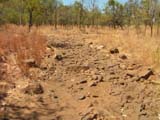
The last section of the way is very rough. We take the OKA
for a ride but do not dare to force the HiLux over the rocks.
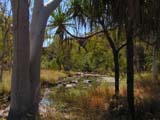
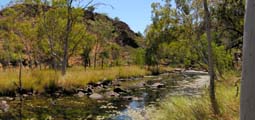
There is plenty of water in the gorge.
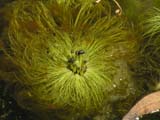
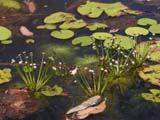


Interesting plants grow in the water.
Also many fruits and flowers can be found but we just can't
find all their names in the books.
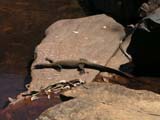
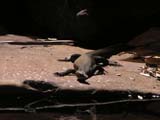
A Mertens' Water Monitor (Varanus mertensi) lays in the
sunshine and enjoys the hot 38°C.
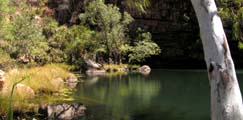
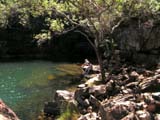
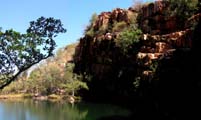
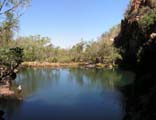
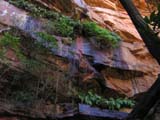
The gorge gets its water from the surrounding rocks. During
the rain season the water penetrates the rock that act like
sponges.
During the dry season the water dribbles out of the rocks
along the walls watering some fern gardens.
The water is surprisingly cold.
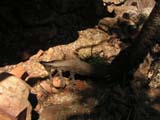
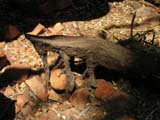
Due to the floods in the river bed there is not much material
left for the trees to hold on to. They cling on to every
stone with their roots.

We proceed towards Galvans Gorge.
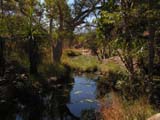
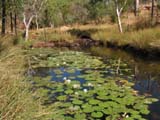
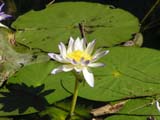
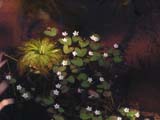
Again we find a small paradise with many different water
lilies and other flowers.
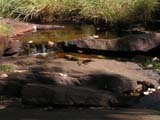
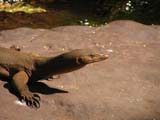
It seems that each gorge has at least one large Mertens'
Water Monitor.
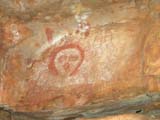
On the right hand side of the water hole the rock painting
of a Wandjina can be found.
Wandjinas represent ancestral beings, spirits of the clouds
and the makers of land, sea and humans.
The figures have very large eyes, a nose but no mouth. They
have some kind of a halo or hair-style.
The Aboriginals believe that these figures or the spirits
they represent control the fertility and regeneration of
life, they control the storms and cyclones.
Each Wandjina is guarded by an Aboriginal family. It is repainted
regularly and ceremonies are held to keep the spirits happy.
We reach Mt. Barnett Roadhouse and find
a nice site close to the pool. Swimming after this hot day
feels just great.
In the evening Ruedi gets a fever, we don't know what it
is.
After a rather cold night with only 12°C we get ready
for a hike to the Manning Falls. As Ruedi
still has a fever he decides to stay in bed.
It is a beautiful day and we enjoy the many flowers and
animal we encounter on the way up.
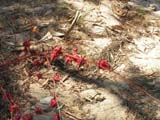
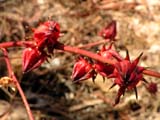
The Native Rosella (Hibiscus sabdariffa) can be eaten or
used to make jam. We have to try that out next time we find
some.
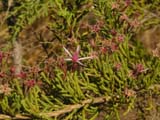
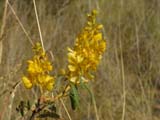
The Desert Fringe Myrtle (Calytrix longiflora) and Firebush
or Chocolate Cassia or Native Senna (Cassia pleurocarpa)
could easily be identified.

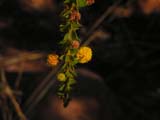
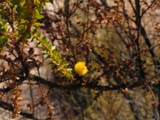
There are wattles with round leaves, triangular leaves,
with and without spikes ....
There are so many different wattles that they don't even
have pictures for all of them in the flower book!
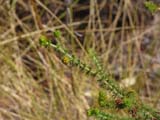
And would you have recognised this one as wattle? According
to our flower book it is a Curry Wattle, Spineleaf Wattle
(Acacia spondyophylla).
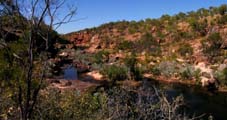
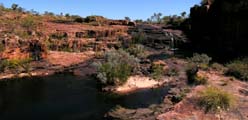
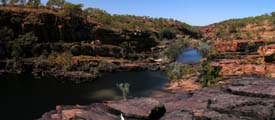

The Manning Falls are just stunning.
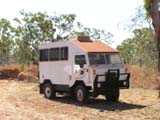
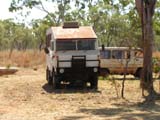
Mt. Barnett Roadhouse owns a very old OKA that was used
for tours.
It has a split front window, very unusual for OKAs.
Today we know that this truck is a pre-production model,
which makes it approx. 25 years old.
As Ruedi's feels a bit better we decide to head off towards
Drysdale River Station but Susi has to drive.
At the Gibb River Road junction (approx. 410 km from Derby
and 280 km from Kununurra) we turn into Kalumburu Road.
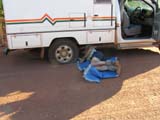
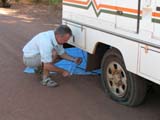
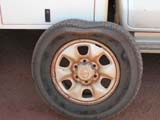
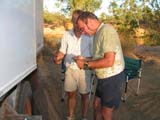
Right after the Gibb River Crossing the
HiLux has a flat tire.
We decide to set up camp at the beautiful crossing and fix
the tire.
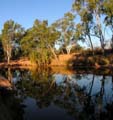
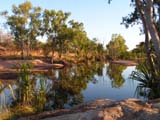
Suddenly there is a big hello. Vanessa, Bruce and their
group have set up camp on the other side of the river and
come over for a swim.
Ruedi is invited to pop over for another jam-session but
because of his fever we decide to decline the offer.
We will decide tomorrow if we can continue towards the
Mitchell Falls or if we return to the Gibb River Road and
head to Kununurra to a hospital to have Ruedi checked up.
After a cold night with only 10°C Ruedi's fever is almost
gone so we decide to continue in direction of the Mitchell
Falls.

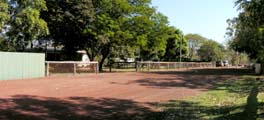
First stop is at Drysdale River Station to
pop up fuel. Boy, they have stiff prices but we have no choice,
the HiLux needs fuel.
We are a bit disappointed about the shop. Compared with Mt.
Barnett Station it has a rather poor selection.


We like this public phone ....
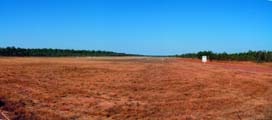
The landing strip at Drysdale River Station is also used
for tourist flights to the Mitchell Falls.

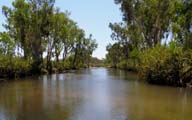
At Miner's Pool we are surprised how much water still runs
in the Drysdale River.
The road up north is in pretty good condition, almost like
it was recently graded.
After we pass the border into Theda Station the road gets
a bit bumpier.
Some 160 km after the Gibb River Road junction we turn left
into the Mitchell Plateau Track.
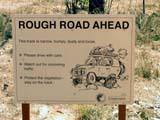
The warning sign on the Mitchell Plateau Track looks a bit
strange as the road is freshly graded.
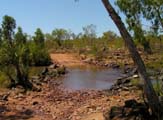
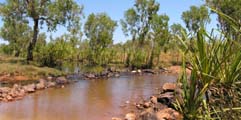
At the first crossing some German tourists with a Britz
Bushcamper cross us. They tell us that the road gets really
horrible, they had to crawl along at 5 kmh which made them
decide to turn around.
We get curious.
What is awaiting us?
Will it really be that big adventure that can be described
in so many books?


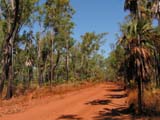
The landscape changes from very hot and dry to small fan
palms (Livistona inermis) and later on to a forest of Livistona
palms (Livistona eastonii).
These palms can only be found on the Mitchell Plateau.
We pass the grader and the road gets quiet corrugated.
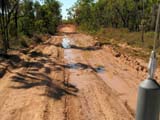
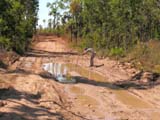

The Mitchell Plateau is the wettest area of Western Australia.
The puddles of water get deeper and muddier.
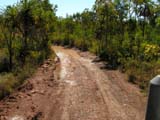
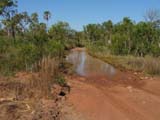
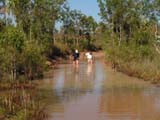
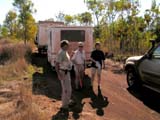
Then we reach a ditch of approx. 80 m that is filled with
brown water. We check it out and find it to be approx. 70
cm deep.
A small creek is constantly feeding water and washes away
the soil that gets loosened by the cars driving through the
ditch.
The OKA has no problems and just wades through.
Click here  to view the movie. to view the movie.
The HiLux could reach its limits. We are in doubt if we
should risk it and drive through or turn around and go back.
But after a group of 5 4WD vehicles passes the section without
major problems the HiLux also makes it through.
The only problem encountered is the muddy water that has
entered into the back-section of the camper and requires
a bit of a clean-out.
After this exciting passage we soon reach the camping area
at the Mitchell Falls and set up for the night.
We still see some 38°C on the thermometer and are a bit
disappointed that the river is so far away.
On Sunday early in the morning Judith and Guido leave for
a hike to the Mitchell Falls.
They want to visit the Bradshaw paintings, rock art that
the local Aboriginals call "rubbish paintings".
The paintings display skinny figures with African-style hair-styles
and arm rings, not Aboriginal style at all.
The local Aboriginals say that none of their ancestors has
created these paintings.
Amazingly the boab tree can be found almost in the same locations
as the Bradshaw pictures can be found ...
We decide to stay in the camp.
This is a wise decision as later on Ruedi's temperature starts
to rise again and he even gets blood cloths in his urine.
Susi decides to give him the antibiotics she usually gets
when she has a bladder infection.
Also the camper is made ready for departure. We want to drive
to Kununurra to the hospital as soon as Judith and Guido
come back.
As the temperature in the shade reaches 40°C Judith
and Guido decide to come along and stay at Drysdale River
Station for the night.
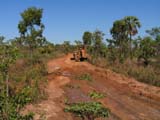
On the way back we meet the grader at the large ditch. He
cannot continue his work.
The driver recons he will need two truck of rocks first to
fill the whole before he can start doing his work.
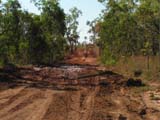
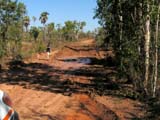

The grader has cleaned up most of the other puddles and
muddy sections but it still is slippery.
We reach Drysdale River Station and check
in.
It has many rules on has to stick to but the toilet block
is great, all individual little bathrooms.
What a treat after this hot and sticky day.
After a comfortable night with 14°C Ruedi feels much
better but we decide to press on to Kununurra and have him
examined at the hospital.
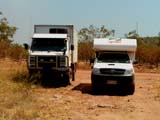
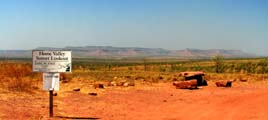
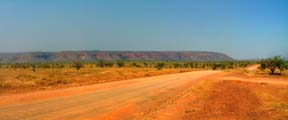
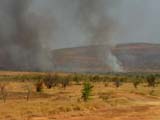
We still find time to stop and enjoy the country. The temperature
has topped 40°C again and many bush fires can be seen.
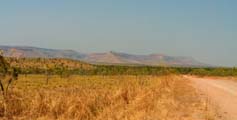
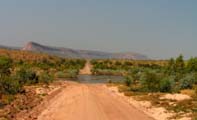
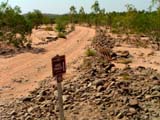
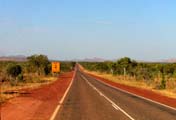
At the Pentecost River Judith and Guido
decide to take the old road to Wyndham while we continue
on the Gibb River Road in direction of Kununurra.
We find a sandy little road just outside of Kununurra and
decide to stay over night.
Soon after we learn that things are not always what they
seem .....
As we set up camp a ute comes along on the other side of
the fence.
A young chap jumps out and asks how we are doing.
Thinking that he is going to send us away Susi replies that
it depends on what he is going to tell us.
He looks a bit puzzled and replies that they had seen us
from the station's window and just wanted to check that we
had not gotten stuck in the sand.
Relieved and at the same time embarrassed Susi explains to
the young man that we had expected to be scared away.
He seems amused about this not understanding how we could
think something like this.
He even goes to the extend of telling us all the good things
to visit around Kununurra and also where the nice camping
spots are.
Well, I guess we still have a long way to go to learn what
hospitality means in this large and friendly country.
|

![]() Created by Level X Webdesign
Created by Level X Webdesign